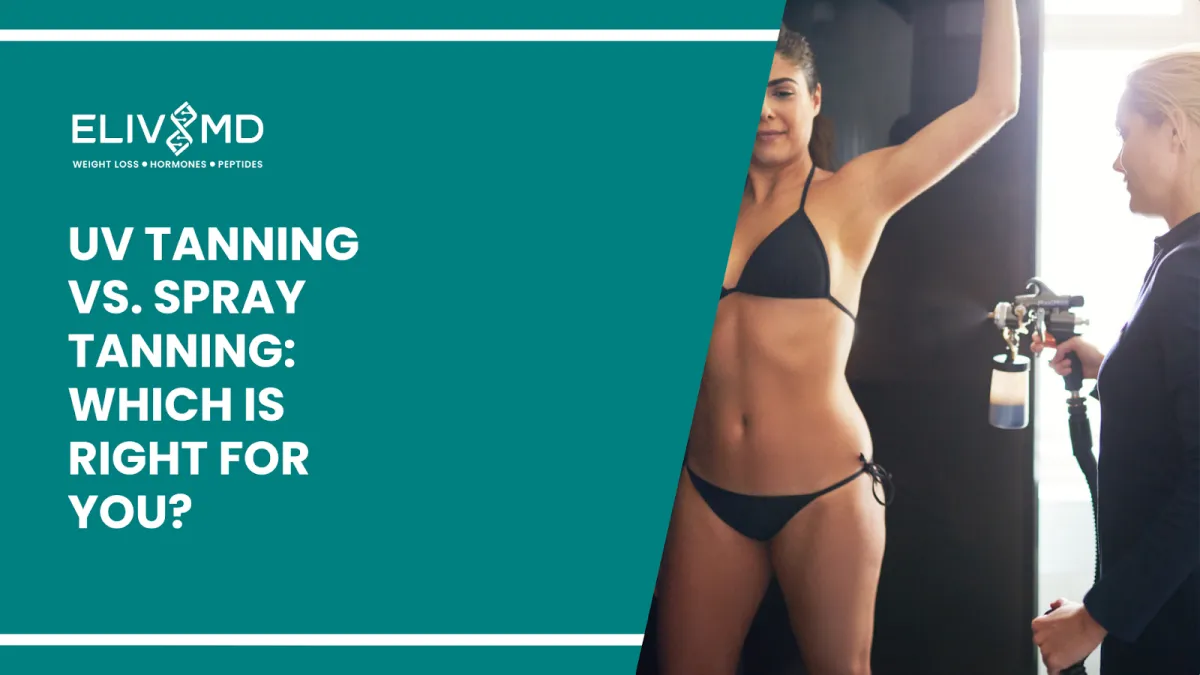Blog
Blog

UV Tanning vs. Spray Tanning: Which Is Right for You?
In the past, people often turned to the sun for that perfect, golden tan. As years went by, the popularity of UV tanning skyrocketed, with tanning beds becoming a go-to solution. However, as more individuals began to notice the negative effects of UV exposure—premature aging, skin damage, and even skin cancer—many began searching for safer alternatives. That’s when spray tanning emerged as a viable option. It offered a way to achieve a beautiful tan without the risks associated with UV rays.
But the question remained: which method was better? Fast forward to today, and the debate between UV tanning and spray tanning continues. With both methods offering quick, glowing results, it can be tough to choose between them.
This blog will break down the key differences between UV tanning and spray tanning, giving you a detailed look at which method is best suited to your skin, lifestyle, and preferences.
What Is UV Tanning? The Traditional Approach
UV tanning has long been the traditional route to achieve a tan. Whether lying in the sun or visiting a tanning bed, UV tanning works by exposing your skin to ultraviolet (UV) rays. These rays trigger the production of melanin, the pigment responsible for your skin’s color. Over time, this exposure leads to a tan, which can last for weeks, depending on how your skin reacts.
The Risks of UV Tanning
While UV tanning can create that sought-after golden glow, it also comes with significant risks. Regular exposure to UV radiation, whether from the sun or tanning beds, damages the skin. Over time, this damage can manifest in the form of sunburns, premature aging, and even skin cancer. UV radiation is classified as a carcinogen by the World Health Organization, which highlights the severe health risks involved.
Moreover, UV rays cause DNA damage in skin cells, leading to cellular mutations. This damage accumulates, making it important to limit exposure to protect your long-term skin health.
Spray Tanning: A Safer, Immediate Alternative
In contrast to UV tanning, spray tanning doesn’t rely on UV exposure at all. Instead, it uses a spray containing dihydroxyacetone (DHA), a compound that interacts with the skin’s outermost layer to produce a tan. When sprayed on the skin, DHA reacts with the amino acids on the surface, resulting in a bronze tone that can mimic a natural tan.
The Benefits of Spray Tanning
The greatest advantage of spray tanning is its safety. Since it doesn’t involve any UV rays, there’s no risk of skin cancer, sunburn, or premature aging from UV radiation. This makes it an ideal choice for individuals looking for a quick and safe tan. Moreover, many spray tanning solutions contain moisturizing ingredients, which help to hydrate and nourish the skin. This leaves you with not just a tan but healthier-looking skin overall.
Another perk of spray tanning is the level of customization it offers. Technicians can adjust the shade of the tan based on your skin tone, ensuring a natural and even look. You can also choose a lighter or darker shade depending on your preference. The results appear within a few hours and can last anywhere from 5 to 7 days, depending on your skin type and aftercare.
Key Differences Between UV and Spray Tanning
Health Risks and Skin Safety
When it comes to skin safety, spray tanning is far superior. With UV tanning, your skin absorbs harmful UV rays, which increases your risk of sunburn, premature aging, and skin cancer.
Spray tanning, on the other hand, involves no UV exposure, making it a much safer choice. It’s a great option for people who want a tan without putting their health at risk.
Tan Longevity
The lifespan of your tan varies between the two methods. UV tanning provides a longer-lasting tan, usually around 2 to 3 weeks. This is because UV exposure stimulates deeper layers of the skin, which take longer to shed.
On the other hand, spray tans typically last for 5 to 7 days. Since DHA works only on the outermost layer of skin, it fades more quickly as your skin cells naturally exfoliate. To maintain the tan, you’ll need to reapply it regularly.
Level of Customization
Spray tanning provides a much higher level of control over your tan. A technician can modify the shade, ensuring that the result is just right for your skin tone. Whether you prefer a light, sun-kissed look or a deeper bronze, spray tanning allows for that flexibility.
In contrast, UV tanning doesn’t offer the same level of control. Your tan is determined by how much melanin your skin naturally produces in response to UV exposure. Although tanning beds may offer different settings for intensity, it’s much harder to achieve a perfectly even or customizable tan through UV tanning.
Which Tanning Method Should You Choose?
When it comes to choosing between UV tanning and spray tanning, the decision comes down to several factors:
If you’re concerned about skin health, spray tanning is the safer option. It offers a tan without any UV exposure, which means you avoid the harmful effects of radiation.
If you’re looking for a long-lasting tan, UV tanning might be your choice, as it can last for up to three weeks. However, be sure to follow proper skin protection protocols to limit the risk of skin damage.
For those who value customization, spray tanning is ideal. You can select the shade that best suits your style and skin type, ensuring a natural, even tan.
If you want a quick and convenient solution, spray tanning is the better option. The process is quick, taking just about 15-30 minutes, and the results appear within a few hours.
FAQs
1. How does UV tanning damage the skin on a cellular level?
UV tanning causes DNA damage in skin cells, which leads to mutations and, over time, increases the risk of skin cancer. UV radiation damages the skin’s structure and accelerates aging.
2. How can I make my spray tan last longer?
To extend the life of your spray tan, keep your skin moisturized and avoid exfoliating. Moisturizing helps the tan stay intact, while exfoliation can cause it to fade more quickly.
3. Does UV tanning provide a deeper tan than spray tanning?
Yes, UV tanning tends to produce a deeper tan as it stimulates melanin production in the skin’s deeper layers. However, it also comes with the risks of UV exposure, which spray tanning does not.
4. Can I go outside in the sun after a spray tan?
Yes, you can go outside after a spray tan, but it’s important to wait at least 6 hours before showering to allow the tan to fully develop. Sun exposure can still darken your spray tan, but it’s best to use sunscreen to avoid damaging your skin.
Conclusion
Both UV tanning and spray tanning offer unique benefits, but the key difference lies in the level of safety. Spray tanning is the better option for anyone looking to avoid the harmful effects of UV exposure, including skin cancer, sunburn, and premature aging. While UV tanning may give you a longer-lasting tan, it carries significant risks that can compromise your skin health.
Ultimately, the best choice depends on your priorities. If you value safety and want to avoid the harmful effects of UV rays, spray tanning is the way to go. For a long-lasting tan, UV tanning may be more appealing, but keep in mind the importance of protecting your skin from further damage.

